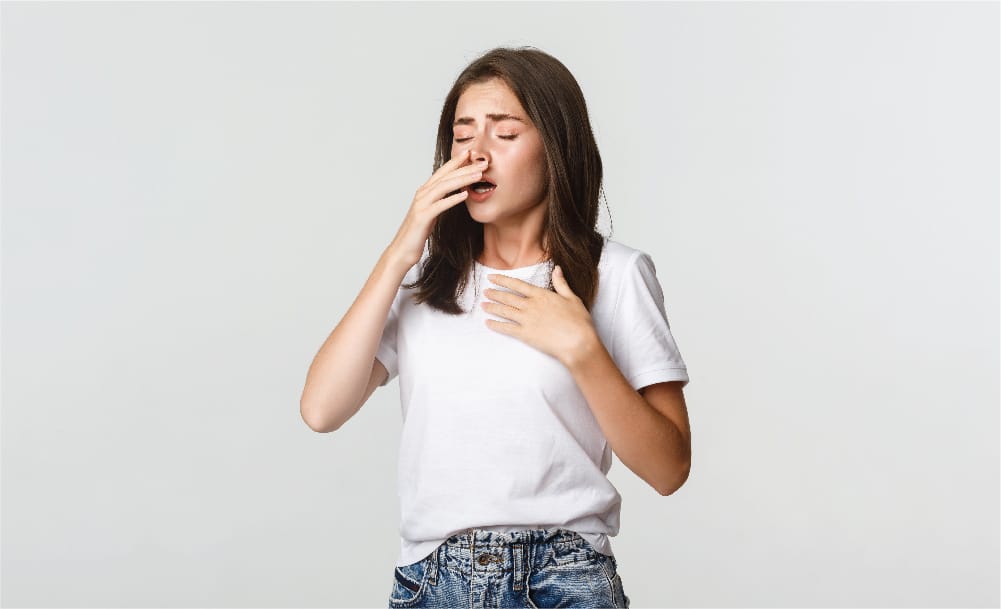What is Allergy?
According to Ayurveda substances which are suitable to the body are known as Satmya while non suitable substances are known as Asatmya. These Asatmya substances cause allergies.
Causes of Allergy
Ayurveda considers Ama (toxins) which is produced due to low digestive fire and low immunity as the primary causes of most allergies. Ama can settle at the digestive level or in the various tissues, with different symptoms at each level. Ama toxicity aggravates Pitta and vitiates blood, or it can aggravate Kapha, with different symptoms. Allergies are caused by overreaction of body’s immune system to certain substances (allergens) that it identifies as harmful. Genetic predisposition, age, sex and race can influence allergic reaction. It can be acute or chronic.
Allergies occur when a hypersensitive immune system reacts to a common or unusual substance. In some people it is hereditary, but one can also develop an allergy at any time in his or her life. Any substance, whatever its origin, is a possible allergen. Foods, preservatives in foods, medicines and environmental factors, including pollen, parasites, dust, animal hair, color for dying hair and chemical toxins can all cause allergic reactions almost anywhere in the body. There are four major ways by which allergen can come into contact and produce allergy – skin contact, injection, ingestion and inhalation.
For treating chronic allergies it is best to detox the body or remove ama by using proper purification procedures.
Types of Allergy and Respective Treatments
1. Spring Allergy
It is a type of allergy that is caused by various pollens in the air. Person who is prone to this allergy suddenly starts sneezing, cough, nasal congestion, watering of the nose and itchy eyes. According to Ayurveda, this disease is caused by the aggravation of Kapha. Accumulated Kapha in late winter gets aggravated (by way of melting) and produces this disease.
The Dos and Don’ts
Avoid all Kapha aggravating foods and drinks like cold dairy, milk, yoghurt, cold drinks, etc. Avoid fruits having cold potency like bananas. Increase Agni (digestive fire) by taking spices that will invigorate this energy like Trikatu (combination of Black pepper, Long pepper and Ginger). Practice daily Pranayama to give strength to the respiratory system and also do Jala Neti. For this, mix 16 ounces of lukewarm water with 1 tsp of salt. Fill it in Neti pot. Then slightly tilt your head and put the nozzle in one nostril and allow the water to flow from the other nose. By this procedure, the entire nasal passage is cleaned and becomes resistant to the pollens floating in the air.
Treatment of Spring Allergy
It is best to do the specific Purification procedure called Vamana or medicated emesis, before the spring season. People prone to allergies should also practice Pranayama to give a boost to the respiratory system.Charaka has given excellent Rasayana therapy to overcome this specific allergy; this can also be used for treating this condition. You should start taking Ashwagandha (Withania somnifera) powder in a dose of 250 mg with 1 teaspoon of cow’s Ghee, early in the morning on empty stomach, at least one month before the spring season.
During the season if the allergy symptoms occur, the dose of Ashwagandha should be doubled e.g. 500 mg with Ghee till the season is over. This is a very effective remedy for Vata and Kapha constitution persons. For Pitta persons, if they cannot tolerate Ashwagandha, they can take Bala powder (Sida cordifolia) in the same method.
2. Hay Fever
Ayurveda considers hay fever as a Pitta disorder. However, people with a Vata constitution suffer most from it, because it is also due to immune disorder and hypersensitivity of the nervous system. Some texts have mentioned this under the title of Trunapushpaka Jwara.
Most common symptoms are – itchy, running, sneezing or stuffy nose, itching eyes, scratchy throat, and itching, swelling, or hives on the skin. Often, people seem to have a cold. With more severe reactions, one might suffer from asthma and other breathing difficulties, aches and pain, gastrointestinal reactions (for example, diarrhoea), or rapid or irregular heartbeats.
Treatment
Herbs: Triphala (mixture of three myrobalan fruits viz. Haritaki, Bibhitaki and Amalaki in equal parts), Trikatu, basil, cloves, camphor, coriander and dandelion are the best herbs.
Home Therapies: Take glass of warm water with 1 tsp. old honey and pinch of turmeric every morning; or take glass of warm water with honey and few drops of lemon juice. Nasya or (nasal medication) can also be used. It is useful for controlling and preventing seasonal allergies. Use medicated sesame oil made with liquorice, Agaru (Aquilaria agallocha), Bilva (Aegle marmalos), antakari (Solanum xanthocarpum), lotus, and nutgrass. Put this medicated oil one drop in each nostril at bedtime. Use this for 4 weeks.
Preparation of Medicated oil
Ingredients: 1 part of herbs + 4 parts of oil + 16 parts of water.
Method of preparation
Make the decoction of herb and water on low fire. Cook it till it becomes 1/8. Heat the oil on low fire. Add slowly filtered decoction in it. Cook it till the water gets evaporated.
Vata Treatment
- Herbs: Trikatu, Triphala, Ashwagandha are herbs of choices to treat hay fever
- Home Therapies: Nasya – This is the special method of putting medicines in the nose. Put 2 drops of medicated sesame oil of Ashwagandha or Bala in each nostril at bedtime.
Pitta Treatment
- Herbs: For Pitta pacification, bitter herbs and blood cleansing herbs like dandelion, barberry, sariva (Indian sarsaparilla) or echinacea should be taken. Take any of these herbs in dose of 1 to 3 gm a day for 2 weeks.
- Diet: Avoid spicy, oily, and fried food.
- Home Therapies:
1. During an attack with Pitta aggravation, take a tea made with liquorice, cardamom and Chandan (Santalum album). Take mint tea. For making tea – take an equal proportion of dried herbs + 4 times water. Boil it. Reduce till 1/4th.
2. Inhale medicated vapour made with water, tulsi or basil leaves, and eucalyptus oil or inhale only the vapour of cabbage.
3. Do Nasya with coconut oil or ghee 2 times a day. Put 2 –3 drops of oil in the nose at bedtime. - Purification Therapy: Give purgation by any suitable herb like triphala or rhubarb.
Kapha Treatment
- Herbs: Camphor, cloves, trikatu, tulsi are herbs of choice.
Take 25 mg. of camphor and cloves and 1 gm. of basil leaves powder twice daily with warm water for 2 months. - Home Therapies:
Nasya: Put 2 drops of Anu Tail (medicated Nasya oil) in each nostril at bedtime.
Prepared Medicines: To ease Kapha aggravation, take 2 tablets of Sookshma Triphala, three times daily with a tea made from basil, cloves and camphor for 2 weeks.
Ayurvedic Physicians may recommend medicated therapeutic vomiting to balance Kapha and prevent the recurrence of seasonal allergies.
Diet: Avoid heavy foods, cold drinks, and dairy products (including cheese and yogurt), that increase Kapha and decrease digestive fire. Also, follow diets that rebalance your own pattern of Doshic imbalance.
3. Skin Allergy
There are several varieties like prickly heat, contact dermatitis, rash or urticaria. Most of these are due to high Pitta.
Dos and Don’ts
Avoid using cosmetic products and colouring products for the hair. Avoid all tight clothing containing nylon. Use simple loose cotton clothing. Avoid too much fried and spicy foods. Eat simple rice, wheat with coconut, coriander and lemon.
Herbs for Skin Allergies
Use herbs like sandalwood, Neem, Sariva, Manjishtha, Haldi and licorice.
Externally application of sandalwood powder mixed with rose water is the best solution.
How to Use Herbs
- To strengthen and improve digestion, take 25 mg of Trikatu and 10 mg of asafetida twice daily, for one week.
- To keep the bowels moving properly take laxative herbs – Triphala, in a dose of 1 to 3 gm every night.
- Take any one of the western herbs like cascara bark, senna, rhubarb root, buckthorn bark, butternut bark, walnut bark.
- Take aloe gel 1-2 teaspoons 3 times a day with warm water.
- To reduce the milk allergy cook the milk with a pinch of dry ginger powder.
How to Prepare the Medicine
- Take 5 gms of Maha Tikta (bitter), Ghee or Ghrita [Panchatikta Ghrita – pancha (five) tikta (bitter) ghrita (ghee) -medicated with katuka (Picrorhiza kurroa), nimba, daruharidra, aloe and vasa (Adhatoda vasica) twice daily]
- For making medicated ghee, prepare a decoction of the herbs. Take 1 part of the decoction + 4 parts of ghee. Keep it on low fire till all water is evaporated. Put a drop of ghee on fire. When it burns without making sound, medicated ghee is ready.
For food allergies, an Ayurvedic physician might use medicated purgation or bloodletting.
Prof. Dr. Subhash Ranade
Chairman, International Academy of Ayurved (www.ayurved-int.com)













